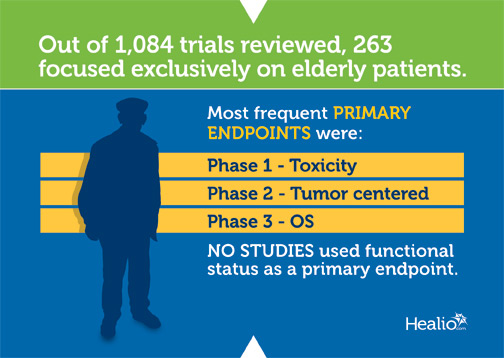Patient-reported outcomes rarely used as endpoints in studies of elderly patients with cancer
Endpoints such as patient-reported outcomes and functional status have been used only moderately in clinical trials of cancer treatments for elderly patients, according to findings published in Annals of Oncology.
“With the aging of the population, the importance of detailed oncology data from older populations has become increasingly relevant,” Olivia Le Saux, MD, of the medical oncology department at Institut de Cancerologie des Hospices Civils de Lyon in France, and colleagues wrote.
Medical societies have established guidelines for clinical trials of elderly patients with cancer.
“The International Society for Geriatric Oncology creation and the publication of the first guidelines on geriatric oncology research methods were published in the early 2000s. This date can be seen as the beginning of geriatric oncology as a scientific field,” the researchers wrote.
Le Saux and colleagues reviewed all phase 1, 2 and 3 trials focusing on cancer treatment in elderly patients between 2001 and 2004 and compared them to trials conducted between 2011 and 2014, evaluating how chosen endpoints used in the studies changed over time. The researchers also included all phase 3 trials of adults with cancer to review subgroup analyses of elderly patients.
Le Saux and colleagues reviewed a total of 1,084 trials: 366 from 2001 to 2004 and 718 from 2011 to 2014. Of these, 263 focused exclusively on elderly patients. The patients’ median age was 72 years in phase 1 trials and phase 2 trials, and 71 years in phase 3 trials.
The most frequently used primary endpoints were toxicity in phase 1 trials (100% in the earlier time period, 93% in the later time period), tumor-centered in phase 2 trials (46% and 68%) and OS in phase 3 trials (33% and 50%).
Use of patient-reported outcomes as secondary endpoints rose over the course of time, from 20% in the period between 2001 and 2004 to 43% between 2011 and 2014; however, this was not statistically significant.
Functional status appeared as an endpoint in just four phase 2 trials in the earlier time period and three phase 2 trials in the later period (6% and 2%, respectively), and was not used in any phase 3 trials. No studies used functional status as a primary endpoint.
“We showed that OS remains the dominant endpoint in trials including elderly oncology patients, as it is in oncology trials more generally,” the researchers wrote. “Yet, the number of clinical trials dedicated to elderly patients remained low. Given the specificities of elderly patients — high competing risk [for] nononcological death; importance of quality of life and importance of independence — we believe that other endpoints deserve special attention. In particular, a focus on disease-specific survival, patient-reported outcomes and functional status would be relevant.” – by Andy Polhamus
Disclosures: The researchers report no relevant financial disclosures.

